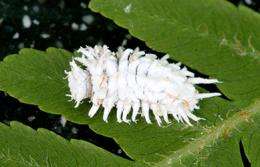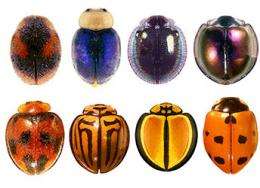Ladybirds - wolves in sheep's clothing

(�鶹��ԺOrg.com) -- CSIRO research has revealed that the tremendous diversity of ladybird beetle species is linked to their ability to produce larvae which, with impunity, poach members of 'herds' of tiny, soft-bodied scale insects from under the noses of the aggressive ants that tend them.
Reconstructing the evolutionary history of ladybird beetles (family Coccinellidae), the researchers found that the ladybirds’ first major evolutionary shift was from feeding on hard-bodied ("armoured") scale insects to soft-bodied scale insects.
“Soft-bodied scales are easier to eat, but present a whole new challenge,” says Dr Ainsley Seago, a researcher with the CSIRO’s Australian National Insect Collection.
“These soft-bodied sap-feeding insects are tended by ants, which guard the defenceless scales and collect a ‘reward’ of sugary honeydew. The ant tenders aggressively defend their scale insect ‘livestock’ and are always ready to attack any predator that threatens their herd.”
Therein lay the evolutionary problem confronting ladybird beetles, whose larvae were highly vulnerable to ant attack.
To avoid being killed as they poach the ant’s scales, ladybird larvae evolved to produce two anti-ant defences: an impregnable woolly coat of wax filaments, and glands which produce defensive chemicals. Most of the ladybird family’s 6,000 species are found in lineages with one or both of these defences.

“We found that most of ladybird species’ richness is concentrated in groups with these special larval defences,” Dr Seago said.
”These groups are more successful than any other lineage of ladybird beetle. Furthermore, these defences have been ‘lost’ in the few species that have abandoned soft-scale poaching in favour of eating pollen or plant leaves.
“This is an unusual way for diversity to arise in an insect group.
“In most previous research, insect species richness has been linked to co-evolution or adaptive ‘arms races’ with plants.”
This research helps to place Australia’s ladybirds in the evolutionary tree of life for insects, and helps us to understand the complex system of mechanisms by which beetle diversity has arisen.
Provided by CSIRO




















